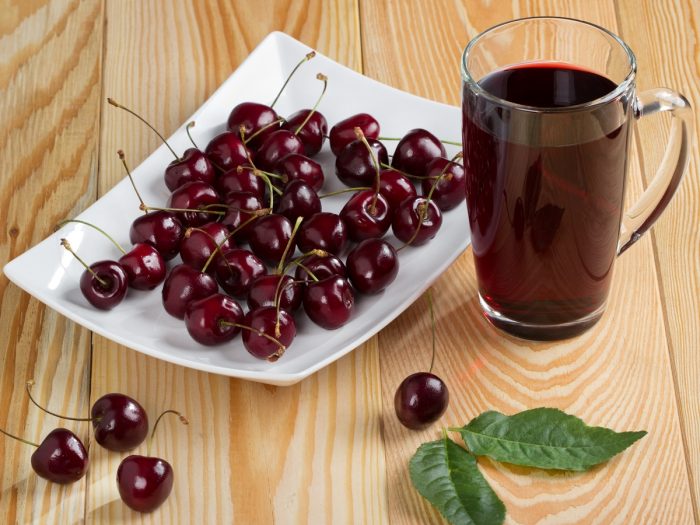Tart cherry is a great way to add some important phytonutrients to your diet, and to enjoy a sour treat!
What are Tart Cherries?
Tart cherries are a species of cherry in the Prunus genus that has a more acidic taste than traditional sweet cherries. Native to Europe and Asia, this cherry bears the scientific name Prunus cerasus and is most popularly made into a nutrient-dense juice. The tree that these cherries grow on is slightly smaller than a sweet cherry tree. There are a few different varieties of the tart cherry including Montmorency, Balaton, Morello, and Amarelle. These sour cherries are sometimes dried and used as ingredients in cocktails and liqueurs, as well as in cakes, tarts, pies, and in certain pork dishes.
Some people prefer a tart cherry extract to their sweet counterparts because of the impressive antioxidant profile in these fruits, despite the mouth-puckering effect these little treats can have. [1]

Fresh tart cherry juice Photo Credit: Shutterstock
Tart Cherry Nutrition
When it comes to nutrition, tart cherries are a rich source of vitamins A & C, as well as dietary fiber, and also low levels of iron and calcium. 100 grams of these cherries only contains about 50 calories. These cherries have a higher anthocyanin content than almost any other food, as well as high levels of ellagic acid and quercetin, which are two other powerful antioxidants. [2]
Tart Cherry Benefits
The most impressive benefits of tart cherries include their ability to do the following: [3]
- Reduce inflammation [4]
- Prevent osteoarthritis
- Lower stress levels
- Lower risk of cardiovascular diseases
- Improve brain health
- Reduce obesity
- Treat insomnia
- Improve the bone mineral density
- Anticancer properties [5]
The high levels of anthocyanins can improve brain health by reducing oxidative stress and plaque deposition, while also preventing certain neurodegenerative diseases. The low-calorie, high-nutrient nature of these cherries make them great for metabolic syndrome, and for reducing obesity, gout, and muscle pain as well.
Studies have found that these cherries can lower stress hormone levels. It can help ease insomnia symptoms, while also relieving the pain and discomfort of arthritis, gout, and other common inflammatory conditions. Good levels of vitamin C and certain key minerals will also boost the immune system and protect bone mineral density. [6]
Tart Cherry vs Black Cherry
- Color: Anthocyanins are responsible for giving fruits their color, which is dark crimson or almost black. When it comes to tart cherry vs. black cherry, the anthocyanin content is far higher in the former.
- Sugar Levels: Tart cherries also have lower levels of sugar, which can make them better for diabetic patients. But due to the powerful sour flavor, it can be a little difficult to consume directly as a fruit.
Sweet vs Sour Cherries
- Eating: Tart cherries tend to be frozen, dried, or blended in juices, while sweet cherries are often eaten fresh.
- Color: Tart cherries don’t lose their coloring when they’re stored or frozen, unlike the other varieties. [7]
- Nutrients: Tart cherries are a better source of nutrients, particularly the anthocyanin content.
- Benefits: Tart cherries are also better for relieving pain and inflammation when compared to sour cherries.
Side Effects
If you are pregnant or breastfeeding, the effects of these cherries may not be favorable for you. Hence, most experts recommend avoiding consumption. Drinking too much of this calorie-dense juice could also increase weight gain, or lead to gastrointestinal distress.
